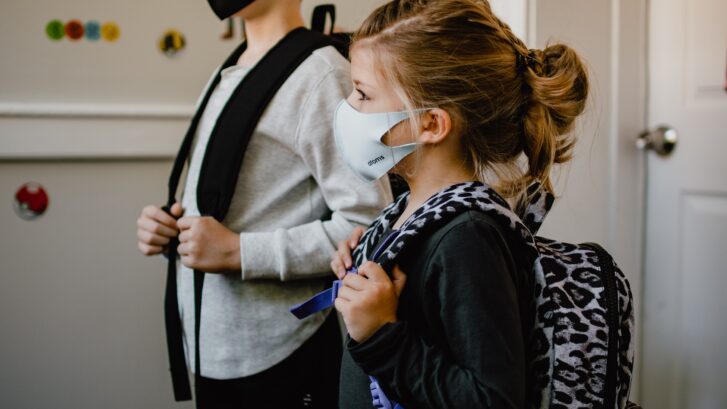More Kids Catch COVID-19
Late last month, the Centers for Disease Control and Prevention (CDC) told the story of a teacher in Marin County, California, who came to work one day in May feeling fatigued, with a little nasal congestion. She brushed it off as allergies.
The teacher, who was not vaccinated against COVID-19, took off her mask just long enough to read to the class during story time. Two days later, she tested positive for the virus. So did half her elementary school class of 24. And so did a total of 27 others in other classes, their parents, and siblings.
Our concierge primary care doctors in Jupiter wanted to highlight this story to demonstrate how easy it is for kids to catch COVID-19, since they are still too young to receive the vaccine.
The school had taken several precautions. This included spacing desks six feet apart, requiring masks indoors, keeping doors and windows open, and installing portable air filters in the classrooms.
“It’s safe to say the . . . case was an unvaccinated person who was eligible to be vaccinated,” Dr. Matt Willis, the county’s public health officer, told the Mercury News.
“All the cases were unvaccinated individuals,” he said. “That includes people who were eligible to be vaccinated but were unvaccinated and people who were not eligible to be vaccinated, by virtue of age.”
Transmission high
This case—and many more like it—illustrates how extremely contagious the delta variant is, compared to the earlier version of COVID-19 we saw last year. At the moment, Florida is leading the nation in daily deaths from COVID-19, which is currently averaging 325 a week.
And kids have come to represent a larger share of those who catch COVID-19. Throughout the pandemic, the percent of kids infected remained fairly steady. They accounted for about 14.6 percent of all those infected with the coronavirus.
For the week ending August 19, however, children in this country made up 22.5 percent of reported weekly coronavirus cases. The CDC reports an average of 276 children were being hospitalized in the U.S. between August 14 and 20. These are the most recent figures available.
Short of keeping kids home from school—which experts agree is detrimental to the children—a combination vaccines and masks are the best tools we have available to protect them. Vaccines, of course, will not be available to children under 12 until possibly late this fall or even winter. But if all the adults around them are vaccinated, that will go a long way toward keeping them safe.
So will universal masking, which numerous studies have shown helps decrease transmission of the virus.
“Masks save lives and reduce the transmission of COVID-19,” Dr. Leslie Diaz, an infectious disease specialist at Jupiter Medical Center in Florida, said recently on CBSN.
“The science is there, masks work, and we should utilize them,” she added. “We are in a crisis . . . the reality is there every day of my life. I can’t dismiss it. Wearing masks has become very relaxed behavior around here, and around the United States. It shouldn’t be.”
Vulnerable schools
The lax behavior she mentions is causing dozens of school closures and quarantines throughout the state.
WPTV reported recently that Florida districts are struggling to keep up with the outbreaks. Since the start of the school year, more than 13,000 students in the district have been out due to a positive case or quarantine.
The cases are impacting teachers as well, leading to more closures. In August, three Miami-Dade County teachers died from the disease.
“It’s just not sustainable when you don’t have the people to run the school,” said Scott Simpson, principal at Treasure Coast Elementary in Indian River County.”
And kids represent an alarming portion of those who catch COVID-19. The most recent figures from the Florida Health Department found the under-12 age group has experienced the most new cases.
Many still believe kids can’t get very sick from a coronavirus infection. The CDC reports, however, more than 49,000 children have been hospitalized with COVID-19 in the last year. Of those, nearly half had no underlying condition or co-morbidities that could have made the disease more serious.
And at least 471 children in the U.S. have died since the outbreak began.
Possible complications
But the risk of death isn’t the only threat facing those who contract the virus, and that includes children.
The American Academy of Pediatrics (AAP) reports even children with mild or no symptoms of the disease can end up dealing with the debilitating symptoms of long-haul COVID-19.
These can include:
- persistent respiratory symptoms, including chest pain, cough, and exercise-induced shortness of breath
- cardiac symptoms including chest pain, shortness of breath, fatigue, and irregular heartbeat
- changes to smell and taste, particularly in adolescents
- “brain fog,” changes or delays in language and academic abilities, motor skills, or mood disorders
Some children can also be subject to multisystem inflammatory syndrome (MIS-C), a rare but serious condition. It causes different body parts become inflamed, including the heart, lungs, kidneys, brain, skin, eyes, or gastrointestinal organs, according to the CDC.
Newer figures show the outbreak in Florida may be starting to level off, but there’s no way of knowing for sure what impact the return of students to campus—and the accompanying games and parties—will have on our numbers. Therefore, prevention is the best tool we have for now.

